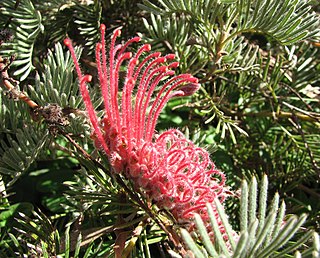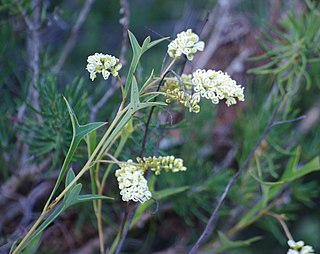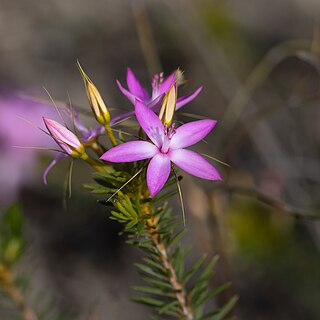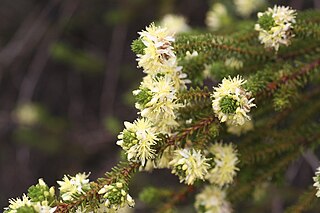
Grevillea thyrsoides is a species of flowering plant in the family Proteaceae, and is endemic to the southwest of Western Australia. It is a small, spreading or low-lying shrub, with pinnatisect to comb-like leaves, the end lobes linear, and clusters of hairy pinkish-red flowers.

Grevillea didymobotrya is a species of flowering plant in the family Proteaceae and is endemic to the south-west of Western Australia. It is an erect shrub with simple leaves, the size and shape depending on subspecies, and cylindrical groups of yellow or cream-coloured flowers.

Calytrix aurea is a species of flowering plant in the myrtle family Myrtaceae and is endemic to the south-west of Western Australia. It is a shrub with elliptic, lance-shaped or linear leaves and clusters of yellow flowers with 25 to 55 yellow stamens in several rows.

Grevillea synapheae, commonly known as catkin grevillea, is species of flowering plant in the family Proteaceae and is endemic to the southwest of Western Australia. It is a prostrate to erect shrub usually with divided leaves with 3 to 7 triangular to more or less linear lobes, and clusters of white to creamy yellow flowers.

Hibbertia hypericoides, commonly known as yellow buttercups, is a species of flowering plant in the family Dilleniaceae and is endemic to the south-west of Western Australia. It is usually a spreading shrub with linear to elliptic or egg-shaped leaves, and yellow flowers, usually with ten to fifteen stamens arranged in a cluster on one side of the two densely hairy carpels.

Grevillea biformis is a species of flowering plant in the family Proteaceae and is endemic to the south-west of Western Australia. It is a shrub with linear leaves and cylindrical clusters of creamy white or pale pink flowers.
Eucalyptus suggrandis is a species of mallee that is endemic to the southwest of Western Australia. It has smooth, shiny bark, linear to elliptical leaves, flower buds in groups of three or seven, creamy white flowers and cup-shaped to conical fruit.
Verticordia dasystylis is a flowering plant in the myrtle family, Myrtaceae and is endemic to the south-west of Western Australia. It is a small shrub, with many stems at its base, oblong leaves and scented, fluffy, yellow and white flowers. There are three subspecies, each of which has a priority conservation status.

Grevillea bracteosa, also known as bracted grevillea, is a species of flowering plant in the family Proteaceae and is endemic to the south-west of Western Australia. It is an erect to spreading shrub usually with linear leaves, and oval to more or less spherical clusters of glabrous pale green to greenish-pink flowers with a pink or white style.

Grevillea florida is a species of flowering plant in the family Proteaceae and is endemic to the south-west of Western Australia. It is a erect, low shrub with linear to narrowly elliptic leaves, and clusters of hairy, white to creamy yellow flowers with a yellow- or orange-tipped style that ages to red.

Grevillea hakeoides is a species of flowering plant in the family Proteaceae and is endemic to the south-west of Western Australia. It is a spreading shrub with flat, linear or more or less-cylindrical leaves and dome-shaped groups of flowers, the colour varying according to subspecies.

Grevillea obliquistigma is a species of flowering plant in the family Proteaceae and is endemic to the south-west of Western Australia. It is a spreading shrub with linear leaves, and conical to cylindrical clusters of creamy-white to yellowish cream-coloured flowers, sometimes tinged with pink.

Calytrix brevifolia is a species of flowering plant in the myrtle family Myrtaceae and is endemic to the west of Western Australia. It is a glabrous shrub with egg-shaped, linear, elliptic or more or less round leaves and clusters of pink to magenta flowers with about 40 to 90 yellow stamens in 4 rows.
Calytrix breviseta is a species of flowering plant in the myrtle family Myrtaceae and is endemic to the south-west of Western Australia. It is a more or less glabrous shrub with egg-shaped, elliptic, lanceolate, oblong or linear leaves and clusters of purple flowers with about 25 to 65 white stamens in several rows, becoming reddish-purple as they age.

Calytrix chrysantha is a species of flowering plant in the myrtle family Myrtaceae and is endemic to the south-west of Western Australia. It is a glabrous shrub usually with oblong to linear leaves and clusters of yellow flowers with about 45 to 55 yellow stamens in several rows.

Calytrix creswellii is a species of flowering plant in the myrtle family Myrtaceae and is endemic to inland areas of Western Australia. It is a spreading, glabrous shrub usually with egg-shaped leaves with the narrower end towards the base, and clusters of white flowers with about 40 to 55 white or yellow stamens in several rows.

Calytrix decandra, commonly known as pink starflower, is a species of flowering plant in the myrtle family Myrtaceae and is endemic to the south of Western Australia. It is a semi-prostrate, glabrous shrub with linear to narrowly elliptic leaves and pink, mauve or magenta flowers with usually 10 stamens in a single row.

Calytrix drummondii is a species of flowering plant in the myrtle family Myrtaceae and is endemic to the Geraldton Sandplains bioregion of Western Australia. It is a glabrous shrub with linear leaves, and yellow flowers with about 55 to 85 yellow stamens in several rows.
Calytrix eneabbensis is a species of flowering plant in the myrtle family Myrtaceae and is endemic to the south-west of Western Australia. It is a glabrous shrub with lance-shaped leaves and purple and yellowish flowers with 40 to 60 stamens in several rows.
Calytrix cravenii is a species of flowering plant in the myrtle family Myrtaceae and is endemic to the south-west of Western Australia. It is an erect, open shrub with linear leaves and clusters of white flowers with 18 to 29 white stamens in several rows.














